It’s unavoidable to be intrigued at first by the ensemble of actors that Aaron Schimberg has assembled for “Chained for Life,” a film about the making of a film that’s clearly financed as an exploitation picture, shipping in a cast with various physical abnormalities for a “Beauty and the Beast”-sequel tale set in a hospital with a traditionally beautiful blonde nurse (Jess Weixler). Yet a funny thing happens as “Chained for Life” wears on – very funny, in fact, thanks to the writer/director’s dry wit, as what’s revealed as grotesque is the machinery of a production that might as well be any number of films that prize the surface of things, but have little going on underneath.
While the film inside “Chained for Life” is helmed by someone who goes by the name of Herr Director (Charlie Korsmo, in his first film role since “Can’t Hardly Wait”), the far more pernicious presence on set is how, with the exception of the pretentious auteur who fills his role ideally well, everyone is seeking an escape from the roles they’ve been cast in based on their looks, whether it is Wexler’s comely Mabel, who is snickered at behind her back for playing a blind woman, or her co-star Rosenthal (Adam Pearson, so memorable in “Under the Skin”), whose tumor-ravaged face speaks nothing to his gentle soul. While experiments are made to go awry behind the scenes for the schlocky sci-fi/horror flick, the unexpected chemistry that happens off of it as Mabel and Rosenthal discover they share more in common than they’d think, based on how they believe others perceive them, leads to something genuinely provocative and moving in a film that may expose the flaws of a popular art that can be so reductive but exemplifies the immense power it can have to see the world through someone else’s eyes.
Recently, Schimberg was gracious enough to answer a few questions over e-mail about the film, which kicks off a national theatrical run this week in New York at the IFC Center and the Nuart.
This is only my second film, but I’ve written a lot of scripts, and all of them deal with disfigurement in some way. Often it’s the focus, sometimes it’s more secondary. It’s a personal interest of mine – I was born with a bilateral cleft lip and palate, and to not write about it feels more unnatural than grappling with it. With “Chained for Life,” I didn’t set out to make a film about disability per se – the word isn’t even in the film. I just wanted to make another personal film.
If you have a disfigurement, you find yourself wondering about people’s perceptions of you. Why do people act so weirdly around you? And as a filmmaker, I think about how cinema has shaped attitudes towards disfigurement. Almost every cinematic portrait of disability that I’ve seen – any character I might see myself in – is negative. Do these cinematic portrayals contribute to people’s prejudices? Or are these characterizations just reflecting something fundamentally true about people’s attitudes – something I don’t want to admit?
I knew I wanted to look at the history of disfigurement in film, and the obvious place to start was Tod Browning’s “Freaks.” I wanted to interrogate my ambiguous feelings towards that movie. It’s a masterpiece, it’s profoundly stupid, it’s humanistic and empathetic, it’s totally ridiculous and insulting. But a masterpiece!
I was interested in people’s perceptions of “Freaks” as well. When it was released, it was essentially suppressed because people didn’t want to have to look at these characters – it was also a huge commercial failure. Now it’s more often fetishized as this cult object, as a kind of counter-cultural signifier. Why is that? A lot of people find the film deeply humanistic. I doubt any person with a disability fully embraces that view.
I try to make sense of the film’s ending, where the so-called freaks disfigure the beautiful Cleopatra as a revenge for betraying them. Is this the ultimate punishment – disfigurement as a punishment crueller than death? Or have they liberated her? That question extends to my own situation – is having a facial disfigurement just a horrible burden, or has it been useful in some way, does it have some inherent worth? Would I change it if I could? Haven’t I changed it already? Wasn’t I born with a giant hole in my face which was surgically closed?
When I have a lot of unresolved questions, that’s a good mental space to start writing a movie. So the initial idea was to continue “Freaks” where it left off – following Cleopatra, or a Cleopatra-like figure, after she’s been disfigured, and seeing how she fares. Ultimately, the movie morphed into something else, but that was sort of where it began.
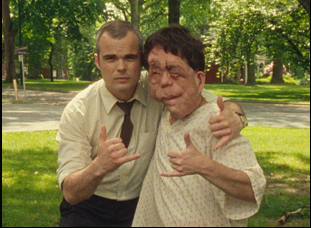
I started writing this before this conversation really moved to the mainstream, but the film does touch upon this issue. Of course, for anyone who feels under-represented on screen, this is not a new concern, so I’m not claiming to be ahead of the curve on it. But when it did come out, we thought, maybe the timing is right for this, maybe there’s a space for it. On one hand I was wary of trying to capitalize on that because it positions the film in a way that feels reductive. Like here’s this year’s film about representation, but the twist is that it’s about disability.
But people are focused on this issue, it’s certainly a worthy and necessary discussion, and it’s a valid context for the film. But it’s not the only context, and maybe it feels a little confining. To be honest, I don’t think any of this helped the film at all. I don’t think disability representation is a pressing subject for many people.
In some ways, I want to avoid talking about disfigurement or disability at all – though clearly I’m failing at that. It’s a personal film, and the freedom you have in a work of art, the ability to explore themes in oblique and multifaceted ways, becomes somewhat compromised as you tailor the conversation to something that conforms to the cultural discourse. But there seems to be no way around it. It’s a weird bind because the film is partially about the marginalization of disability, and by extension, the film itself becomes marginalized by virtue of being about disability.
Was it difficult to sell people on idea it wouldn’t be exploitative?
I’ve never once worried about the film being exploitative. I think nearly every film about disability has been exploitative or misguided and I started my film as a kind of corrective. It isn’t the only version of a corrective. It isn’t any kind of definitive work – it can’t single-handedly counter every previous negative portrayal, and it can’t speak for every disfigured or disabled person’s experience. But I feel confident in my ability to use my own experience as a guide. I hesitate to speak for anyone else, but every person with a disability in my film told me they’re proud of the film and have waited for something like this to come along.
Nobody has directly accused the film of being exploitative, but people – able-bodied people – dance around it. No one has put forth any argument as to why it might be exploitative – no one suggests the characterizations are offensive. The subtext of the argument seems to be that someone like Adam appearing on film at all is inherently exploitative – that the viewer can look at him, have feelings about him, judge him, and that those feelings are the film’s responsibility and not the individual viewer’s. As if Adam doesn’t have agency, isn’t self-aware, doesn’t know what it’s like to be looked at, as if he doesn’t deal with this shit every day, as if he should be ashamed of himself. As if he might not know what you might be thinking. But I would ask anyone who would ask me if I’m exploiting him to ask him if he feels exploited by me. And if he says no, ask yourself why you don’t accept his answer.
Adam comes off as this shy milquetoast in the film, which makes you feel in some way protective of him, but Adam is one of the most extroverted and gregarious people I know – watch any interview with him and you’ll see right away how completely different he is from Rosenthal, how subtle and complex his performance is. The shyness and social awkwardness is closer to my own personality, and Adam is in some ways doing an impression of me – which amused him. He finds me very neurotic.
How’d you pull Charlie Korsmo out of acting retirement?
Charlie’s one of the smartest people I’ve ever met, so this was really a rare lapse in judgement on his part. He has no desire to have an acting career – he’s a successful law professor. I happened to catch him while he was going on sabbatical. He liked the script – particularly the ending. He’s been in some of the biggest-budget films ever, he’s worked with some of the most legendary American directors. This entire film cost a fraction of what any of his other films cost on any given day of shooting – like Dustin Hoffman’s weekly per diem on “Hook” is the cost of my film. Actually, Charlie’s weekly per diem on “Hook” probably cost as much as our film. But he seemed to enjoy himself. He said the experience was basically the same as on “Dick Tracy,” with worse catering. Without Madonna breathing down his neck.
We would wrap for the day and he’d drive several hours to go to some legal conference in Cleveland. He’s usually very clean-cut, but because of his character, he looked grimy and hungover. All his lawyer pals asked him what the hell happened to him and he told them that it’s for a role. They thought he was joking. I’ve probably ruined his chances of making it to the Supreme Court.
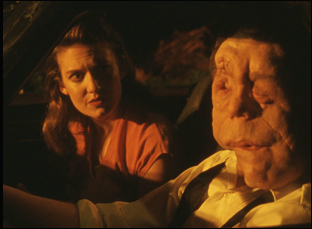
There was always some period element to it since I had originally been thinking about a film related to “Freaks.” So it was set at a circus sideshow, back when circus sideshows were actually relevant. But I quickly abandoned that idea and moved it to a hospital, where I could reference mad scientist movies – another genre where disfigurement and disability loom large. I could also bring up the issue of eugenics.
I didn’t want to do a period film, because I can’t afford it. But also I grew bored with exploring past attitudes and transgressions towards disability. I wanted something set in the present moment, but by having this mad scientist period piece within the movie, I could examine how attitudes have shifted – or haven’t shifted. When you’re dealing with the past, a modern viewer can easily distance himself from outdated mores. Discrimination has in a way become more sophisticated – like years ago, a guy like Trump might proudly declare himself a racist, but now he has to pretend that it’s the furthest thing from what he is, even if it’s only by saying “I’m the least racist person in the world.”
It’s an amazing estate where the film takes place. Where did you find this location?
It’s in Harrisburg, PA – most of it, anyway. My producer Vanessa and I took a road trip every weekend for months, and we looked at dozens of places – old hospitals, old hotels, old mansions. Most of them were totally dilapidated but I thought it could be interesting to show how the film crew builds up one wing of the place during the course of the film, transforming it into something like a real working hospital in the middle of total desolation. There was an old Borscht Belt hotel that we almost shot in, but then I fell through the floor, and I thought, someone is definitely going to die, I’ll have blood on my hands, or I’ll be the one who dies, or we’ll all die. But it really could have been an interesting location. We gave up on the idea of shooting somewhere toxic – for one thing, Vanessa was pregnant – and when we found the place in Harrisburg, which was pristine, we went with that. The other thing is, when I walked into the Harrisburg place, I could immediately see how we would shoot some of the more complicated scenes – stuff I’d been worried about since I wrote the script suddenly fell into place.
There are a lot of long master shots, does it take a lot of time or rehearsal to pull those off just right?
I didn’t have rehearsal time – that’s a luxury we couldn’t afford. It would be helpful, I think. I like to just show up every day and figure out what we’re doing. I don’t even do shot lists, which drives producers crazy. Sometimes you have a shot in mind when you’re writing, and other things come to you when you see the location. Occasionally I’d show up and have no idea what the hell to do – then I’d look at Adam Minnick, the DP, and he’d have an idea. We had strict rules about the film’s look, we put a lot of limitations on ourselves – combine that with limited time and money, and you learn to get inspired quickly and work fast. Then it really becomes a question of the cast and crew being able to rise to the occasion on command – and I never had a problem. I could not have done it without them. I had an incredible team. It’s their movie as much as mine.
Long shots with a lot of characters and movement are kind of intuitive – there’s always something motivating the action. The thing that stumps me every time is two people sitting in a chair talking to each other for five minutes. That’s the stuff where I just stand there with my face in my hands feeling totally incompetent.
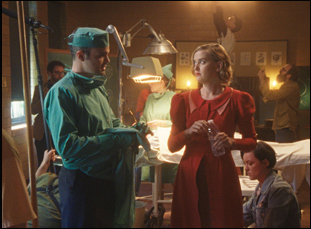
I had zero interest in showing the inner-workings of a film set, I didn’t want the film to be a bunch of inside jokes about filmmaking. Hell, I’ve only made one other movie, who am I to make a film about filmmaking? I was only interested to the extent that I could relate it to these issues of disfigurement and the cinematic history of disability. I kept trying to write the film crew out of it but it became important to have the relationship between Mabel and Rosenthal unfold in a contained environment – we implicitly understand why these two characters were brought together, and everyone around them understands that, so it becomes difficult to gauge how much of the relationship is genuine or performative. Furthermore, the film takes place in a professional environment, where you’re not going to see any outright acts of discrimination or anything illegal – although I stretch that a bit by having the disabled cast sleep in separate quarters. Viewers might distance themselves from characters whose behavior is socially unacceptable. Everyone knows what cruelty looks like. I wanted to show more insidious acts of prejudice.
Anyway, so I actually went out of my way to make the film set feel unrealistic. Every word out of the film crew’s mouth had to relate to the themes of the film. Even if they’re talking about equipment or other films, there’s some kind of thematic resonance. And in fact, every real crew member hated their onscreen counterpart. The real DP hated the fake DP’s costume. “She would never wear that on set! It makes no sense!” Every department had some complaint – and they’re right! It’s all totally inaccurate.
It really was a logistical nightmare though, trying to keep track of everyone, figuring out how many – or few, preferably – characters you need to sell the illusion of a film crew. One of the problems with writing a film which takes place in a contained environment in a remote location, is that every person who shows up can never leave. So, I’d write “Mabel is talking to a reporter” and now a reporter is hanging around the whole movie and I have to account for her whereabouts in every scene. A cop shows up for one throwaway joke. Now he’s hanging around for the rest of the film. So it just grows and grows – I swear I wanted to do a movie with four or five people in it. Now there are 50 characters and I have to keep track of them while I’m writing and then in the frame. Scheduling the film was a nightmare. Every scene – who’s in it? Who has to be on set? Let’s put the gaffer in the background. Oh, we haven’t seen the boom operator for 7 scenes, put him in there. But wait, was he just seen hanging around in the last scene? Do we even need this character? What if he does something funny in the background and the audience falls in love with him and waits for him to reappear in every scene? Is my friend who’s playing the role ever going to speak to me again? He has to stay in Harrisburg with us, show up every day, not get paid for it, just to walk through a door in the background to give the illusion of a film crew. Really stressful. Even though I tried to make the film set feel unrealistic, it ends up capturing the hectic nature of a film set pretty well.
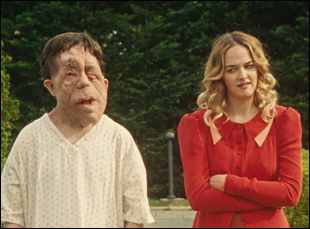
I don’t have any particular conversation in mind. It certainly feels to me like the screenings have gone well – which was not my experience with my film first. I don’t know what power any film has to shape people’s attitudes, but I think a lot of people are getting something out of it. Every screening has been wildly different, but people seem to really enjoy it. That’s what they tell me to my face anyway.
As I’ve played the film in different parts of the world, I’ve learned about the varied attitudes different countries have towards disability. I was asked in one country – fairly progressive country – “I don’t understand why you made this – don’t you think all these people should just be locked up? Why should we have to look at them?” And the audience just kind of nodding their heads in agreement. I’m thinking, do I have enough frequent flier miles to get out of here by midnight?
The comedy plays differently everywhere. Different jokes resonate. There are two jokes that I’m convinced are hilarious that no one has ever laughed at. Am I wrong? Is everyone else wrong? There’s only one joke that has played well at every single screening in every country – it’s a joke about “My Struggle.” In Greece, the film played to nearly 1000 people, and I think people liked the film, but no one laughed the whole time – dead silence for 88 minutes until this joke about “My Struggle” and the room erupted in the loudest laughter I’ve ever experienced. The only place they didn’t laugh at “My Struggle” was in Berlin. And I thought, well, at least they got it.
“Chained for Life” opens on September 11th in New York at the IFC Center and September 13th in Los Angeles at the Nuart. A full schedule of cities and dates is here.




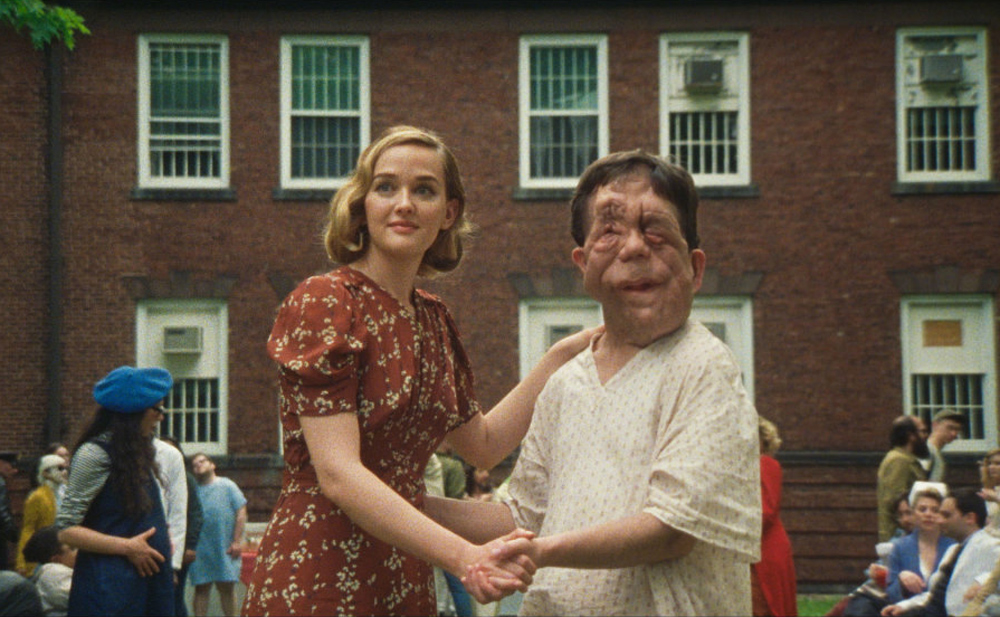
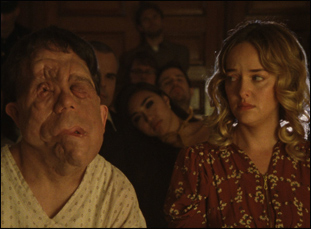
Comments 2